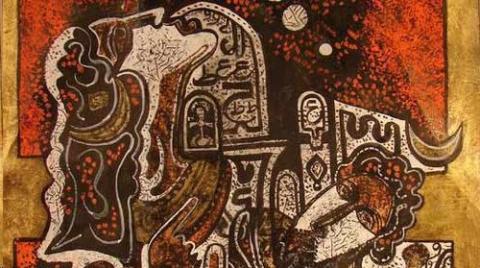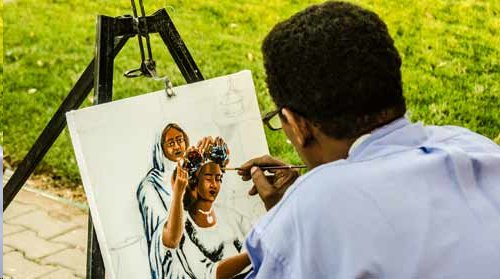A Cultural Renaissance Emerges Amidst the Economic Chaos of Sudan

From New America Media:
Sudan’s rich contemporary arts history is seldom acknowledged amidst all the headlines about war, poverty, and famine that make it to the global media. After World War II, when graduates of Khartoum’s Gordon Memorial College School of Design formed the movement known as the Khartoum School, artists like the father of Sudanese modernism, Ibrahim Elsalahi, calligrapher Osman Wagialla, and Ahmed Shibrain pioneered a unique fine arts movement that reflected a confluence of African, Arab, and Islamic influences. The next generation of artists emerging in the 1970s included painters like Bakri Bilal and Rashid Diab, who focused on painting and color. Sudan was a center for the Afro-Arab art experience.
However, in a developing country like Sudan, with its history of political instability, rigid military rule, and socio-economic struggles, art has been on the country’s backburner for decades since that time. Most Khartoum School artists were able to flourish abroad, and make a name for themselves and Sudan while living outside of it.
So when I visited Khartoum in December 2012, it was exciting to witness a change in attitude, a renewed appreciation of art. It was a renaissance; Sudanese artists reclaiming their space.
As you drive down Nile Avenue on Saturday afternoon, you see, with the glistening Nile River as their backdrop, at least 10-15 painters showing their works. They can’t afford to hold exhibits, so the Nile banks are their galleries. Portraits, close-ups, abstracts, nature; all lined up against the huge century-old Mahogany trees that line the street. Admirers walk through the paintings, chatting with the artists. This scene is new to this country. These artists are pioneering a movement of art appreciation among the lower-middle income population, breeding the notion that despite the economic situation, art is to be created, appreciated, and supported.
That philosophy is shared by Rashid Diab, a painter who took it upon himself to help revolutionize the Sudanese arts scene. The Spanish and American-educated Ph.D. holder created the country’s first arts and culture center that houses artists in-residence from around the world. The Rashid Diab Arts and Culture Center in the Gireif neighborhood in the east of Khartoum is, in itself, a work of art. Diab joined five villas, painted and decorated them each inspired by a geographical part of Sudan; there’s the Nubian villa with its ancient Nubian wall carvings, the Western villa with its Darfur and Kordofan- inspired art. And everything, he says, is made in Sudan.
Diab is passionate about supporting and flaunting local, home-grown products, art, and is a huge DIY-er. The center is filled with art made from everyday items that Diab found in Khartoum’s many junkyards- toothbrushes, steel cups, broken glass from perfume bottles are set into cement creating the floor. Everything glimmers in the sun.

Every Sunday, Diab holds a cultural event where he invites artists, thinkers, poets, and authors to a panel discussion on a topic - from where art is going in Sudan, to traditional wedding songs, and there’s always live music at the end. All free of charge. Diab says the government doesn’t stand in his way, but it doesn’t help either- especially not through any kind of funding. So, he reached deep into his own pockets to make the center happen, and turned to corporate sponsorship through companies like the Kuwaiti Zain, one of the premier telecommunications companies with a Sudanese presence, that is big on sponsoring arts and culture events. This concept of corporate sponsorship is also new to Sudan, and seems is only available due to the immense budgets of foreign companies like Zain and Samsung.
”K CITY”
Samsung Sudan is also playing a part in the artistic revolution happening in Khartoum. However, its focus is on the younger set. The company sponsors a new magazine called In the City. Issued in both English and Arabic, a space for young artists and poets to express themselves, also listing the many cultural happenings around Khartoum. This in itself is new and played a role in fostering a burgeoning English-speaking youth spoken word and poetry scene that was created by the editor of the magazine. Mustafa Khogali. Khogali was raised in Kuwait, educated in the US, and moved back to Sudan, he says, “to make creative spaces for young people”, who are often forgotten and neglected in most of Sudan’s cultural sphere.

As English-speaking, Western-minded children returned with their families from the US, Canada, and the UK in the mid 2000s following the economic oil boom of the time, that led to a population of kids, teens and young adults who found themselves in a largely teen-wary environment suspicious of their Westernization. A place that lacked avenues for entertainment as they know it.
That’s where Khogali came in. His magazine, with the sponsorship of Samsung, created a radio show by the same name. Then, another one, especially for young poets, rappers, and singers to showcase their talents. Soon, both the magazine and radio show grew and Khogali began to partner with places like the British Council to hold live Open Mic events, and talent shows where young musicians, painters, poets, singers, and comedians can find an audience. There’s one rule: no politics. Perhaps that is one of the main reasons this formula worked. The youth quickly caught on, and Khartoum, now affectionately dubbed “K-town,” is a happening, lively place for these youngsters to blossom. Perhaps this generation will be the one that helps Sudan re-emerge as the hub of Afro-Arab art that it was in the past.
Author Bio:
Hana Baba is a Sudanese-American reporter and co-host of Crosscurrents, the evening newsmagazine on KALW Public Radio 91.7FM in San Francisco.
Photos: Painting by Bakri Bilal; Outdoor Artist on Nile Avenue, credit: Ahmed Elno'man; Traditional bridal suite at the Rashid Diab Arts and Culture Center, credit: Hana Baba






























































































































































































































































































































